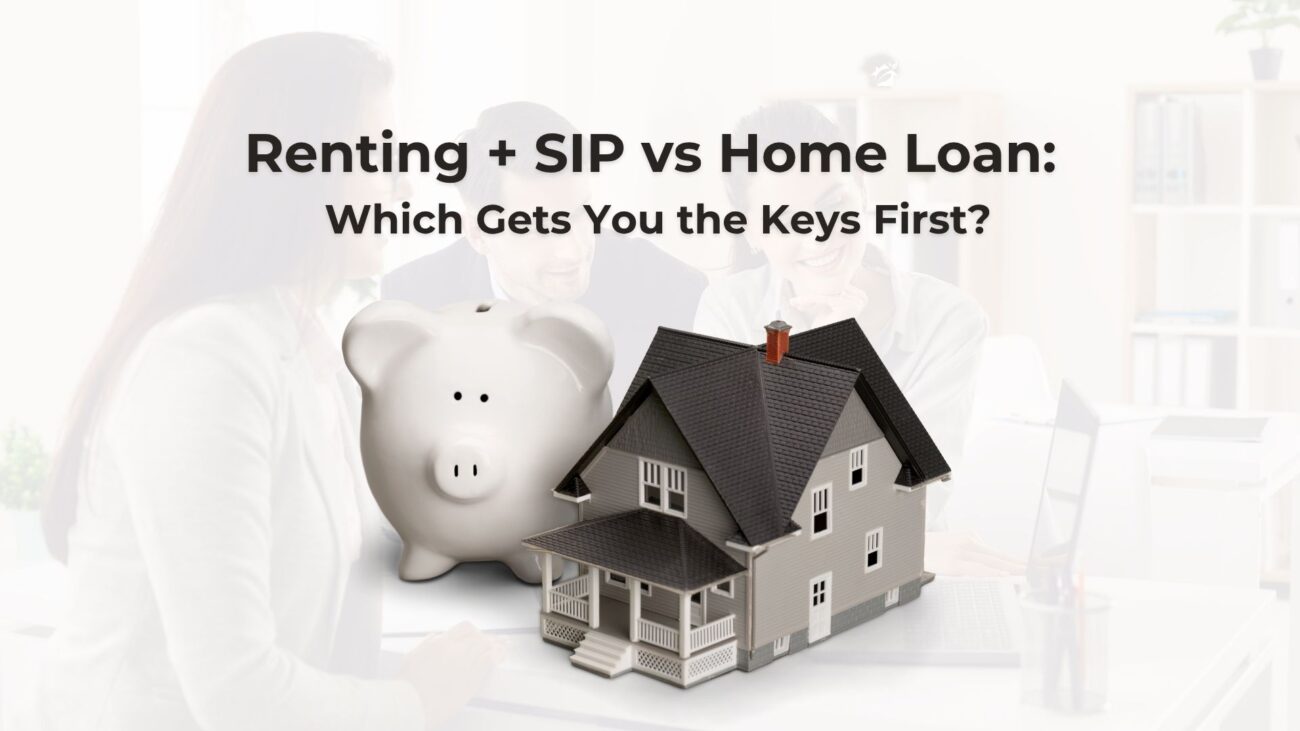Thinking about having your own home? The ₹70 lakh home loan vs SIP debate has been around but one crucial angle is often overlooked: rent savings when you buy now. We’ve updated the analysis with ₹20,000/month rent and deepened the insights to help you make a smarter choice.
Why Rent Savings Matter 📉
When you take a home loan and move in, that same ₹20,000 you would’ve paid in rent now stays in your pocket or can be used elsewhere. That’s real money saved, not theoretical gains from investments.
Example:
If you delay home purchase by 10 years, your rent payments total:
₹20,000 × 12 × 10 = ₹24 lakh spent with no ownership or returns.
This rent outflow should be included in the SIP route but not in the home loan route. Let’s break it all down.
Option 1: Buy Now with ₹70 Lakh Home Loan

Assume you buy a ₹77.78 lakh home with a ₹70 lakh loan:
-
Loan: ₹70 Lakh
-
Down payment: ₹7.78 Lakh
-
Interest rate: 8.5%
-
Tenure: 20 years
-
EMI: ₹60,677/month
Total EMI Outgo: ₹60,677 × 240 = ₹1.45 Crore
Total Interest Paid: ₹75 Lakh+
Ownership: Immediate
Tax Benefits: Applicable under Sec 80C & 24(b)
🏡 Rent Savings
By moving in now, you save ₹20,000/month in rent:
-
₹20,000 × 12 × 10 = ₹24 Lakh saved over 10 years
-
After 20 years, rent saving increases to:
₹20K × 12 × 20 = ₹48 Lakh
Effective advantage: You’re living in your home, asset is appreciating, and you’re saving on rent.
Option 2: SIP for 10 Years (₹60,677/month)

Or, invest the EMI amount into a SIP at 11% CAGR:
-
Monthly SIP: ₹60,677
-
Period: 10 years
-
Total Invested: ₹72.8 Lakh
-
Corpus (before tax): ₹1.26 Crore
-
LTCG Tax (10% on gains > ₹1 Lakh): ₹5.32 Lakh
-
Final Corpus: ₹1.21 Crore
🏠 Home Price after 10 Years
At 5% annual appreciation, the home you buy today is worth:
-
₹77.78 × (1.05)^10 = ₹1.27 Crore
Your SIP corpus of ₹1.21 Crore is short by just ₹6 Lakh but SIP strategy also pays no loan interest.
Option 2A: SIP + ₹24 Lakh Rent Paid
But if you rented for 10 years, you’d also pay ₹24 Lakh in rent. Your total outflow:
-
SIP investment: ₹72.8 Lakh
-
Rent: ₹24 Lakh
-
Total spent: ₹96.8 Lakh
That’s significantly higher than the home loan outgo when you save rent.
Side-by-Side Snapshot
| Comparison Metric | Home Loan Buyer | SIP Investor (10 yrs) |
|---|---|---|
| Monthly outgo | ₹60,677 EMI | ₹60,677 SIP + ₹20,000 rent |
| Total outgo (10 years) | ₹72.8 Lakh | ₹92.8 Lakh (₹72.8 + ₹20) |
| Asset after 10 years | Home valued ₹1.27 Cr | ₹1.21 Cr corpus |
| Net value (Asset – Cash spent) | ₹1.27 Cr – ₹72.8 L = ₹54.2 L | ₹1.21 Cr – ₹92.8 L = ₹28.2 L |
| Ownership timeline | Immediate | After 10 years |
| Debt obligation | Yes | None |
| Liquidity | Low | High |
| Tax benefits | Home loan claims | LTCG tax on gain |
| Emotional peace | High | Low till purchase |
The Rent + SIP Realization 🚨
-
Home Loan: You live in your home, asset appreciated ~1.27 Cr, spent ₹72.8 L, saved ₹24 L rent = net gain ~₹54 L in asset value.
-
SIP Investor: Spent ₹92.8 L total (investment + rent), ends with ₹1.21 Cr corpus = net gain ~₹28 L.
Even ignoring loan interest, home loan wins homeownership + asset appreciation with rent savings.
Everything Compared: Full Table
| Parameter | Home Loan | SIP Route |
|---|---|---|
| EMI/SIP | ₹60,677/month | ₹60,677 investment + ₹20,000 rent |
| Tenure | 20 years | 10 years investment + rental period |
| Total Spent | ₹72.8 L | ₹92.8 L |
| Asset Value | ₹1.27 Cr home | ₹1.21 Cr corpus |
| Net Gains | ~₹54 L | ~₹28 L |
| Ownership | Day one | After 10 years |
| Emotional satisfaction | High | Low until purchase |
| Debt | Yes | No |
Final Verdict 🎯

✅ If you want immediate ownership and long-term savings:
Go with the house now and save rent. Home loan still costs more in interest, but you own the asset and save ₹20,000/month on rent.
🕒 If you’re fine renting and investing:
SIPs build wealth, but you spend extra on rent for years – cutting into your returns and delaying homeownership.
Suggestions to Optimize Returns
-
Buy smaller/nearby to save on rent quicker
-
Prepay EMI with appreciation to reduce interest
-
Combine SIPs with loan to maximize return and home equity
You might like this: Mastering Financial Discipline: 10 Habits That Can Change Your Life Forever
❓ Frequently Asked Questions

-
Does rent saving matter?
Yes, ₹20K monthly rent saved turns into ₹24 L saved over 10 years – real money in your pocket. -
Is EMI better than SIP returns?
SIP returns (~11%) exceed interest (8.5%), but rent outflow negates that advantage. -
Can SIP investors offset rent?
Only if you invest rent money too, but that requires higher savings and discipline. -
Should I mix SIP with EMI?
Yes, build wealth while paying down home debt. -
What if rent is lower?
Even ₹10K rent makes homeownership financially stronger. -
Does maintenance reduce benefits?
Factor in 1–2% annual maintenance; but rent saving often outweighs it. -
Is renting always bad?
Not always, short-term or uncertain living conditions make rent practical for a while. -
Are interest rates on loans likely to rise?
Yes, higher rates raise EMI or extend tenure, but rent usually increases more over time. -
What about mobility and flexibility?
If you’re moving cities often, renting might make more sense initially. -
What tax benefits do home loans offer?
Deduction under Section 80C for principal and 24(b) for interest on loans up to ₹2 L per year.
📢 Full Disclaimer
Disclaimer:
Investing in mutual funds is subject to market risks. Consult your advisor before making any investment.

